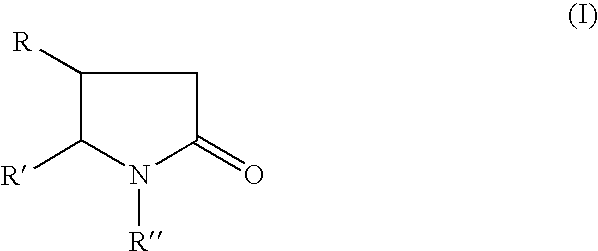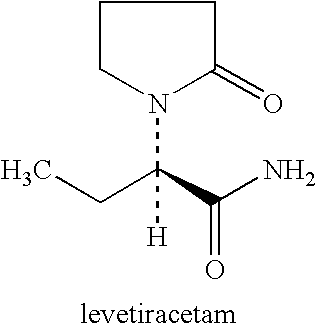Method for treating apathy syndrome
a technology of apathy and pyrrolidine, applied in the field of 2oxopyrrolidine compound in the treatment of apathy syndrome, can solve the problems of prolonged hospitalization, diminishing therapeutic responses, social and occupational functioning as well as self-care, and achieve the effect of improving frontal or executive cognitive functions
- Summary
- Abstract
- Description
- Claims
- Application Information
AI Technical Summary
Benefits of technology
Problems solved by technology
Method used
Image
Examples
example 1
Treatment of Apathy in Post-Stroke Patients
[0060]The activity of nefiracetam to improve apathy and / or cognitive function in post-stroke patients has been demonstrated by a controlled clinical trial against placebo. In this trial, nefiracetam was administered orally to 103 post-stroke patients, who all have some degree of depression, for up to twelve weeks after the vascular event. Concurrently, 56 patients received placebo (placebo group). Of the 103 post-stroke patients treated with nefiracetam, 55 received 600 mg daily (600 mg group), and 48 received 900 mg daily (900 mg group). The three groups of patients were followed for up to 12 weeks, and evaluated at the end of week 4, the end of week 8, and the end of week 12, by measuring the Apathy Evaluation Scale (a symptom scale for measuring apathy), and by measuring SDMT (for measuring cognitive function).
[0061]There was a dose-dependent and time-dependent change in apathy syndrome for the nefiracetam-treated patients in comparison ...
example 2
Treatment of Apathy in Depression Patients
[0066]In 151 post-stroke patients having moderate to severe depression, the intervention-free data of Apathy Scale (AS), as a valid measure of apathy, and of Hamilton Rating Scale of Depression (HAM-D) and Beck Depression Inventory (BDI), as valid measures of depression, were collected and analyzed using the method of confirmatory factor analysis. HAM-D and BDI are fully validated and are widely used measures of the severity of depression. HAM-D (Hamilton, J Neurol. Neurosurg. Psychiatry. 23:56-62, 1960) is rated by a professional. BDI (Arch Gen Psychiatry. 4:561-571, 1961) is rated by a patient.
[0067]The 151 patients, who were evaluated at least once after treatment, included the 103 patients studied in Example 1. The 151 patients were divided in three groups each orally receiving placebo (51 patients) or nefiracetam at 600 mg / day (54 patients) or nefiracetam at 900 mg / day (46 patients).
[0068]The data at the end of 12 weeks were analyzed an...
PUM
| Property | Measurement | Unit |
|---|---|---|
| frequency | aaaaa | aaaaa |
| stress | aaaaa | aaaaa |
| synaptic transmission | aaaaa | aaaaa |
Abstract
Description
Claims
Application Information
 Login to View More
Login to View More - R&D
- Intellectual Property
- Life Sciences
- Materials
- Tech Scout
- Unparalleled Data Quality
- Higher Quality Content
- 60% Fewer Hallucinations
Browse by: Latest US Patents, China's latest patents, Technical Efficacy Thesaurus, Application Domain, Technology Topic, Popular Technical Reports.
© 2025 PatSnap. All rights reserved.Legal|Privacy policy|Modern Slavery Act Transparency Statement|Sitemap|About US| Contact US: help@patsnap.com



